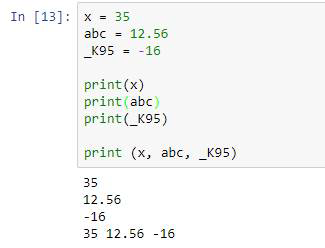2-1 資料型態
print語法是在print函式中放進你要印的東西,比如 print(我要印這個)。說聲 Hello World,跟程式的世界打聲招呼吧!
第一個跟世界打招呼的程式!
print的內容可以是變數(variable): print(a),數字(init): print(1234),或是字串(string): print(‘abc123’)
變數
- 容器,可以存放資料
- 變數名稱有區分大小寫!
- 命名原則:第一個字元必須是英文字,其餘可用英文、數字及底線符號
- 不能單獨使用保留字當成變數名稱,包括:
andasand
assertasbreakassertclassbreakcontinueclassdefcontinuedeldefelifdelelseelifexceptelseexecexceptfinallyexecforfinallyfromfor from globalifimportimportininisislambdalambdanotnotororpasspassprintprintraiseraisereturnreturntrytrywhilewhilewith yield
if
基本資料型態
變數在程式中,扮演中儲存資料的角色。將資料儲存下來,就可在需要的時候拿出來用。
在程式中,每個變數會有自己的型別。那型別是什麼呢? 簡單來說,型別決定了這個變數可用來儲存什麼樣格式的資料,並且定義了相對應的操作。
簡單舉例,Python中常見的基本型別有:int (整數)、float (浮點數)、str (字串)。
從上述你大概可以知道,如果要今天存放年齡,整數會是不錯的選擇。
身高 & 體重? 浮點數看來不錯。 名字? 字串是不二之選!
不過在Python中,宣告變數並不用事先給定型別,他會依照你給他的初始值來決定變數的型別。
資料型態的轉換
常用的轉換函數:
int(x) : 把x轉換為整數
float(x) : 把x轉換為浮點數
str(x) : 把x轉換為字串
-
int(x [,base]) Converts x to an integer. The base specifies the base if x is a string.
-
float(x) Converts x to a floating-point number.
-
complex(real [,imag]) Creates a complex number.
-
str(x) Converts object x to a string representation.
-
repr(x) Converts object x to an expression string.
-
eval(str) Evaluates a string and returns an object.
-
tuple(s) Converts s to a tuple.
-
list(s) Converts s to a list.
-
set(s) Converts s to a set.
-
dict(d) Creates a dictionary. d must be a sequence of (key,value) tuples.
-
frozenset(s) Converts s to a frozen set.
-
chr(x) Converts an integer to a character.
-
unichr(x) Converts an integer to a Unicode character.
-
ord(x) Converts a single character to its integer value.
-
hex(x) Converts an integer to a hexadecimal string.
-
oct(x) Converts an integer to an octal string.
練習題
a="123"
b=456
計算出 a+b = 579

